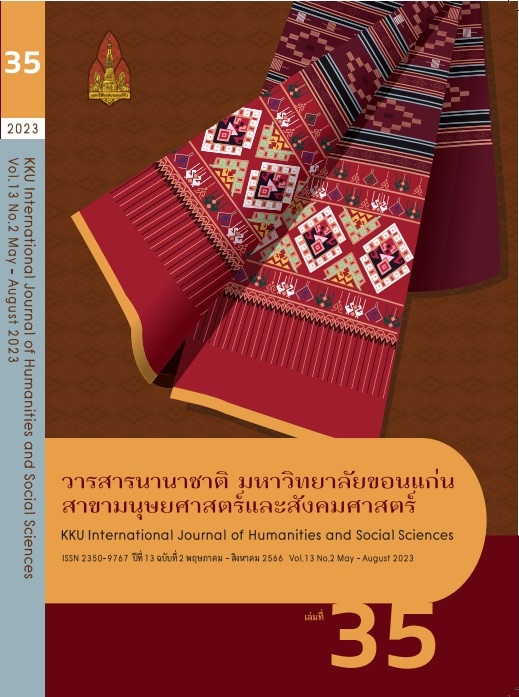The Development of Local Wisdom on the Locally Woven Clothes to Community Innovation in the Border Communities in Ubon Ratchathani Province
Main Article Content
Abstract
The work was a qualitative research. It aimed to study the local wisdom used in the locally woven clothes in the border communities in Ubon Ratchathani province, and to develop the community innovation model for the locally woven clothes according to the concept of a creative economy. The research instruments were an in-depth interview, and a participatory and non-participatory observation. The targets were local scholars, community leaders, and local cloth weaving groups. The research found that the local wisdom employed in the locally made cloth weaving process could be classified into two categories. 1) Local wisdom for production of the cloth weaving equipment could be subdivided into a loom, a bobbin, a spindle, a shuttle and a cotton swap. 2) Local wisdom used in the local industry and cloth weaving handicraft could be divided into the following. 2.1) Tied cloth dyeing featured the following patterns: a circular-shaped pattern, a common tied cloth pattern, a heart-shaped pattern, a rice stalk pattern. 2.2)The design called Laikhit had the following patterns: a flower pattern, a butterfly pattern, an elephant-shaped pattern, a squid-shaped pattern. 2.3) The weaving pattern called Phalaijok was commonly known in the following local names: Laijokdao, Laijokphatam, Laijochang, and Lajjokplabeuk. The cloth weaving steps were as follows: growing cotton crops, harvesting, sorting out the texture, spindling cotton, dyeing the cotton, spinning cotton and weaving. The development of the local innovation model in the border communities of Ubon Ratchathani province had four stages. 1) A forum was organized to gather the opinions of the communities concerned. 2) The innovation model for the local cloth weaving was developed. 3) Acquired knowledge was returned to the communities concerned. 4) The community innovation involved an application of innovation in a creative economy. With the innovation fully used, the local wisdom would be useful to the community economy, a communal strength and stability. The items which were the products of the community innovation were home-madebelts, a mobile case, keychains, and a book cover.
Article Details
References
โกมาตร จึงเสถียรทรัพย์. (2559). วิถีชุมชน เครื่องมือ 7 ชิ้นที่ทำให้งานชุมชนง่ายได้ผล และสนุก. พิมพ์ครั้งที่ 12. นนทบุรี: สุขศาลา.
จักรกริช สังขมณี. (2561). Limology ชายแดนศึกษา กับเขต-ขันธ์วิทยาของพื้นที่ใน/ระหว่าง. กรุงเทพฯ: ศยาม.
จารุวรรณ ธรรมวัตร. (2543). ภูมิปัญญาอีสาน. มหาสารคาม: คณะมนุษยศาสตร์และสังคมศาสตร์ มหาวิทยาลัยมหาสารคาม.
จุฑามาศ ดอนอ่อนเบ้า และจิรวัฒน์ พิระสันต์. (2563). นวัตกรรมการพัฒนาผ้าฝ้ายทอมืออัตลักษณ์ท้องถิ่นจังหวัดเลย. วารสารศิลปกรรมศาสตร์ มหาวิทยาลัยขอนแก่น, 12(2), 22-42.
ชาติชาย มุกสง. (2549). ฟาสต์ฟู้ดกลายพันธุ์: การเปลี่ยนแปลงความหมายของอาหารกับการบริโภคเชิงสัญญะข้ามวัฒนธรรม. ใน ปริตตา เฉลิมเผ่า กออนันตกูล (บรรณาธิการ). รายงานการวิจัยฉบับสมบูรณ์ (เล่มที่ 1) โครงการสังเคราะห์ความรู้และจัดประชุมเรื่อง“วัฒนธรรมบริโภค” เพื่อจัดประชุมประจำปีทางมานุษยวิทยาครั้งที่ 5. 214-261. กรุงเทพฯ: ศูนย์มานุษยวิทยาสิรินธร (องค์การมหาชน).
ธวัช ปุณโณทก. (2531). ภูมิปัญญาชาวบ้านกับการพัฒนาชนบท. กรุงเทพฯ: หมู่บ้าน.
นิธิ เอียวศรีวงศ์. (2536). การศึกษาของชาติกับภูมิปัญญาท้องถิ่น. กรุงเทพฯ: อมรินทร์พริ้นติ้ง.
ปริตตา เฉลิมเผ่า กออนันตกูล. (2548). ภูมิปัญญาไทย-ภูมิปัญญาเทศ. กรุงเทพฯ:ศูนย์มานุษยวิทยาสิรินธร (องค์การมหาชน).
พัฒนา กิติอาษา. (2546). มานุษยวิทยากับการศึกษาปรากฏการณ์โหยหาอดีตในสังคมไทยร่วมสมัย. กรุงเทพฯ: ศูนย์มานุษยวิทยาสิรินธร (องค์การมหาชน).
ยศ สันสมบัติ. (2559). The Border คน พรมแดน รัฐชาติ. กรุงเทพฯ: ภาพพิมพ์.
วัฒนะ จูฑะวิภาค. (2555). ผ้าทอกับวิถีชีวิตคนไทย (รายงานผลการวิจัย). กรุงเทพฯ:มหาวิทยาลัยธุรกิจบัณฑิตย์.
สนิท สินทิพย์. (25 ธันวาคม 2563). สัมภาษณ์. ผู้นำกลุ่มวิสาหกิจชุมชนผ้าทอพื้นบ้านบ้านกุ่ม ตำบลห้วยไผ่ อำเภอโขงเจียม จังหวัดอุบลราชธานี.
สุนันทา เจริญปัญญายิ่ง และธนวัฒน์ เดชปรอท. (2561). การศึกษาศักยภาพการค้าและการขนส่งชายแดนด้านจังหวัดอุบลราชธานี ต่อการเปิดประตูเข้าสู่ AEC (รายงานผลการวิจัย). กรุงเทพฯ: สถาบันการขนส่งจุฬาลงกรณ์มหาวิทยาลัย.
สุริยา สมุทรคุปติ์ และพัฒนา กิติอาษา. (2537). แม่หญิงต้องต่ำหูก: พัฒนาการของกระบวนการผ้าทอและการเปลี่ยนแปลงบทบาทของผู้หญิงในหมู่บ้านอีสานปัจจุบัน (รายงานผลการวิจัย). นครราชสีมา: สำนักวิชาเทคโนโลยีสังคม มหาวิทยาลัยเทคโนโลยีสุรนารี.
สำนักงานคณะกรรมการนวัตกรรมชุมชน. (2563). นวัตกรรมท้องถิ่นจัดการตนเอง. กรุงเทพฯ: สำนักพัฒนานวัตกรรมชุมชนจัดการความรู้และสื่อสาร.
อาคม เติมพิทยาไพสิฐ. (2553). กิจกรรมปรับกระบวนทัศน์ของประเทศสู่เศรษฐกิจสร้างสรรค์. กรุงเทพฯ: กระทรวงการต่างประเทศ.
อานันท์ กาญจนพันธุ์. (2545). วิธีวิทยาของวิธีคิดในการตั้งโจทย์วิจัยทางสังคมศาสตร์.วารสารพฤติกรรมศาสตร์, 8(1), 21-37.


